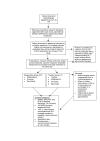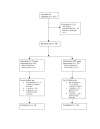The effectiveness of motorised lumbar traction in the management of LBP with lumbo sacral nerve root involvement: a feasibility study
- PMID: 18047650
- PMCID: PMC2217540
- DOI: 10.1186/1471-2474-8-118
The effectiveness of motorised lumbar traction in the management of LBP with lumbo sacral nerve root involvement: a feasibility study
Abstract
Background: Traction is commonly used for the treatment of low back pain (LBP), predominately with nerve root involvement; however its benefits remain to be established. The aim of this study was to test the feasibility of a pragmatic randomized controlled trial to compare the difference between two treatment protocols (manual therapy, exercise and advice, with or without traction) in the management of acute/sub acute LBP with 'nerve root' involvement.
Methods: 30 LBP patients with nerve root pain were recruited and randomly assigned to one of two treatment groups. Primary outcome measures were the: McGill pain questionnaire, Roland Morris disability questionnaire, and the SF36 Questionnaire; recorded at baseline, discharge, 3 and 6 months post-discharge.
Results: 27 patients completed treatment with a loss of another four patients at follow up. Intention to treat analysis demonstrated an improvement in all outcomes at follow up points but there appeared to be little difference between the groups.
Conclusion: This study has shown that a trial recruiting patients with 'nerve root' problems is feasible. Further research based upon a fully powered trial is required to ascertain if the addition of traction has any benefit in the management of these patients.
Registration number: ISRCTN78417198.
Figures






Similar articles
-
A randomized clinical trial of the effectiveness of mechanical traction for sub-groups of patients with low back pain: study methods and rationale.BMC Musculoskelet Disord. 2010 Apr 30;11:81. doi: 10.1186/1471-2474-11-81. BMC Musculoskelet Disord. 2010. PMID: 20433733 Free PMC article. Clinical Trial.
-
Mechanical Traction for Lumbar Radicular Pain: Supine or Prone? A Randomized Controlled Trial.Am J Phys Med Rehabil. 2018 Jun;97(6):433-439. doi: 10.1097/PHM.0000000000000892. Am J Phys Med Rehabil. 2018. PMID: 29309314 Clinical Trial.
-
Sub-classification based specific movement control exercises are superior to general exercise in sub-acute low back pain when both are combined with manual therapy: A randomized controlled trial.BMC Musculoskelet Disord. 2016 Mar 22;17:135. doi: 10.1186/s12891-016-0986-y. BMC Musculoskelet Disord. 2016. PMID: 27005470 Free PMC article. Clinical Trial.
-
No effect of traction in patients with low back pain: a single centre, single blind, randomized controlled trial of Intervertebral Differential Dynamics Therapy.Eur Spine J. 2009 Dec;18(12):1843-50. doi: 10.1007/s00586-009-1044-3. Epub 2009 May 31. Eur Spine J. 2009. PMID: 19484433 Free PMC article. Clinical Trial.
-
Effectiveness of Mechanical Traction for Lumbar Radiculopathy: A Systematic Review and Meta-Analysis.Phys Ther. 2021 Mar 3;101(3):pzaa231. doi: 10.1093/ptj/pzaa231. Phys Ther. 2021. PMID: 33382419
Cited by
-
Assessment of variability in traction interventions for patients with low back pain: a systematic review.Chiropr Man Therap. 2018 Sep 17;26:35. doi: 10.1186/s12998-018-0205-z. eCollection 2018. Chiropr Man Therap. 2018. PMID: 30237870 Free PMC article.
-
Non-Surgical Approaches to the Management of Lumbar Disc Herniation Associated with Radiculopathy: A Narrative Review.J Clin Med. 2024 Feb 8;13(4):974. doi: 10.3390/jcm13040974. J Clin Med. 2024. PMID: 38398287 Free PMC article. Review.
-
The Functional and Morphological Changes of the Cervical Intervertebral Disc after Applying Lordotic Curve Controlled Traction: A Double-Blind Randomized Controlled Study.Int J Environ Res Public Health. 2019 Jun 19;16(12):2162. doi: 10.3390/ijerph16122162. Int J Environ Res Public Health. 2019. PMID: 31248064 Free PMC article. Clinical Trial.
-
Traction for low-back pain with or without sciatica.Cochrane Database Syst Rev. 2013 Aug 19;2013(8):CD003010. doi: 10.1002/14651858.CD003010.pub5. Cochrane Database Syst Rev. 2013. PMID: 23959683 Free PMC article.
References
-
- van Tulder MW, Becker A, Bekkering T, Breen A, Carter T, del Real MT, Hutchinson A, Koes B, Kryger-Baggesen P, Laerum E, Malmivaara A, Nachemson A, Niehus W, Roux E, Rozenberg S. European guidelines for the management of acute nonspecific low back pain in primary care. European Commission, Research Directorate General. COST B13 Working group; 2004. http://www.backpaineurope.org - PMC - PubMed
-
- Waddell G. The back pain revolution. Edinburgh. Churchill Livingstone; 1998.
Publication types
MeSH terms
Associated data
LinkOut - more resources
Full Text Sources
Medical
Miscellaneous

